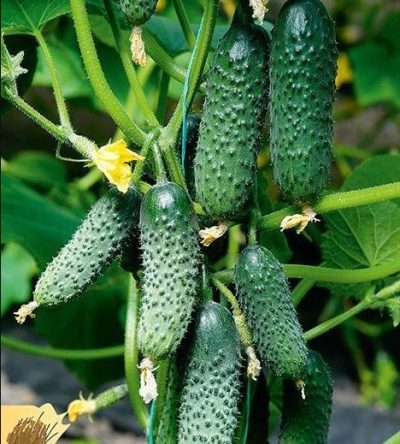
- Authors: ENZA ZADEN BEHEER B.V.
- Name synonyms: Cedric
- Year of approval: 2015
- Growth type: indeterminate
- Branching: the average
- Fruit weight, g: 105
- Fruit length, cm: 12-14
- Fruit color: dark green with very short stripes
- Cucumber Mosaic Virus Resistance: stable
- Ripening terms: early
The dream of every gardener is to collect 15-20 or more kilograms of cucumbers from one square meter of area. And there are varieties for which this is the norm. For example, the Dutch hybrid Cedric. In addition to high yields and early ripening, the crop has other attractive qualities.
Breeding history
Cedric is a first generation productive hybrid. It was obtained by specialists on the basis of the well-known agricultural company ENZA ZADEN BEHEER B. V. from the Netherlands, which is one of the world leaders in the seed market. The greenhouse facilities of this company are located in many countries, and this makes it possible to produce high-quality planting material all year round.
Cucumber Cedric quickly managed to conquer farmers with its qualities, it is actively grown all over the world. Passed variety trials in the Russian Federation, and in 2015 the culture was entered into the State Register.
Description of the variety
Cedric is an early ripening hybrid, as well as a parthenocarpic hybrid, for its intended purpose it is salad and canning. Begins fruiting already at 38-45 days. Given such a short growing season, farmers often grow it both in the spring-summer and in the summer-autumn turnover. Harvesting twice a day makes commercial cultivation of the variety effective. I like the hybrid and simple gardeners.
Characteristics of the appearance of plants and zelents
The Dutch varietal cucumber has rather powerful roots, which, even in not very favorable conditions, are able to provide the bush with all useful substances.
Cedric is a plant of an indeterminate type of growth. The height of the main lash should be reduced forcibly by pinching the crown.
The leaves on the liana are of medium size, painted in green tones, shoots appear in small quantities. Flowering female type, in each axil on the main stem 2-4 fruits are formed, ripening alternately. If you collect greens regularly, it will stimulate fruiting.
Zelentsy is distinguished by the shape of an elongated cylinder, their average dimensions are 12-14 cm, and their weight is 105 grams. There are short white thorns on the dark green medium-lumpy skin.
Purpose and taste of fruits
Cucumbers of the described Dutch hybrid variety have a universal purpose. They are eaten fresh, for example, in summer salads, as part of burgers and sandwiches, when decorating snacks. They are also suitable for pickling, canning, and 5-centimeter gherkins in the form of gherkins are successfully pickled. Juicy and crispy flesh will never taste bitter, which is inherent in the genetic level.
Maturation
An early maturing culture begins to bear fruit as early as 38-45 days after germination.
Yield
The Dutchman belongs to the high-yielding varieties. On average, 15 kilograms of zelents are obtained from 1 m2.
Growing and care
Given the predominant cultivation in greenhouse conditions of closed ground, Cedric is cultivated mainly in seedlings. Since this is a hybrid, seeds must be purchased, preferably from trusted suppliers. The planting material of the professional series at the seed enterprise undergoes mandatory pre-planting processing. Therefore, it does not need to be additionally soaked or processed in any way.
It is highly undesirable to dive cucumber seedlings, therefore, it is better to sow seeds in small containers of 0.5 l or more. After the appearance of 4-5 leaves, the germinated seedlings of Cedric are transferred to the greenhouse. The yield claimed by the originators can only be obtained under greenhouse conditions. When cultivating a crop in a garden bed, the result can be unpredictable, since the hybrid variety is specially bred for indoor ground. However, it is perfectly grown in the southern vegetable gardens of the country.
The recommended planting scheme is 50x50 cm. This means that 3 plants are placed on an area of 1 m2 of a bed, no more. Dutch cucumbers are warm and moisture-loving. The culture prefers loose, fertile soil.

In order to collect strong, tasty and beautiful cucumbers on your site, you need to make top dressing. Lack of nutrients can negatively affect the appearance of the plant and significantly reduce the yield. Fertilize cucumbers with organic fertilizers in combination with mineral fertilizers. With the right balance of these components and adherence to the fertilizing schedule, the cucumber yield will be maximum.
Disease and pest resistance
The Dutch hybrid has a fairly strong immunity. Cedric resists ailments such as:
- olive spot;
- powdery mildew;
- cucumber mosaic.
With illiterate care, plants can grow weak, they can suffer from fusarium wilting, as well as peronosporosis.

Despite their popularity, cucumbers are often attacked by diseases and pests. From them, cucumber plantings often die before the start of fruiting. In order to prevent this from happening, it is necessary to try to prevent ailments or get rid of them at the very beginning, having studied in detail their causes of occurrence, signs and methods of treatment.





























































































